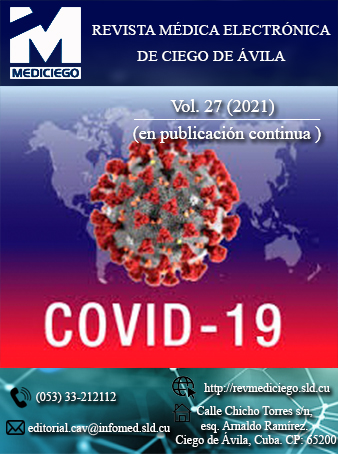Clinical and epidemiological characterization of COVID-19 in the first four weeks of the pandemic
Abstract
Introduction: COVID-19 (disease caused by the SARS CoV-2 coronavirus) was detected for the first time in Wuhan, China, in December 2019.
Objective: to describe some clinical and epidemiological variables of COVID-19 patients during the first four weeks of the pandemic.
Methods: a cross-sectional descriptive study was developed whose universe was the total number of patients diagnosed with SARS-CoV-2 in Ciego de Ávila province, during the first four weeks of the pandemic. The following variables were analyzed: case criteria, age, sex, origin municipality, reported symptoms, chronic diseases, and clinical course of COVID-19. Summary measures were percentages and absolute frequencies.
Results: 63,41 % of the 82 confirmed cases were close contacts of patients with confirmed or suspected infection. The most affected were between 25 and 29 years old (21,95 %); among patients aged 60 years and over, the proportion was 15,85 %. Most were female. There were transmission events in four municipalities, with a predominance of asymptomatic infected people. The most reported symptoms were: fever, cough and sore throat. Arterial hypertension (4,88 %) and diabetes mellitus (6,10 %) were the most frequent chronic diseases. In the majority, the infection evolved favorably; two patients died.
Conclusions: COVID-19 spreads rapidly within the community. The study provided a clinical and epidemiological characterization of the disease, useful to execute immediate actions by health decision-makers in the province, as well as to develop prevention strategies in the communityDownloads
Published
How to Cite
Issue
Section
License
Copyright (c) 2022 Silvia Estelvina Retureta Milán

This work is licensed under a Creative Commons Attribution-NonCommercial 4.0 International License.
Those authors who have publications with this journal accept the following terms of the License CC Attribution-NonCommercial 4.0 International (CC BY-NC 4.0):
You are free to:
- Share — copy and redistribute the material in any medium or format for any purpose, even commercially.
- Adapt — remix, transform, and build upon the material for any purpose, even commercially.
The licensor cannot revoke these freedoms as long as you follow the license terms.
Under the following terms:
- Attribution — You must give appropriate credit , provide a link to the license, and indicate if changes were made . You may do so in any reasonable manner, but not in any way that suggests the licensor endorses you or your use
- No additional restrictions — You may not apply legal terms or technological measures that legally restrict others from doing anything the license permits.
The journal is not responsible for the opinions and concepts expressed in the works, which are the exclusive responsibility of the authors. The Editor, with the assistance of the Editorial Committee, reserves the right to suggest or request advisable or necessary modifications. Original scientific works are accepted for publication, as are the results of research of interest that have not been published or sent to another journal for the same purpose.
The mention of trademarks of specific equipment, instruments or materials is for identification purposes, and there is no promotional commitment in relation to them, neither by the authors nor by the editor.






















